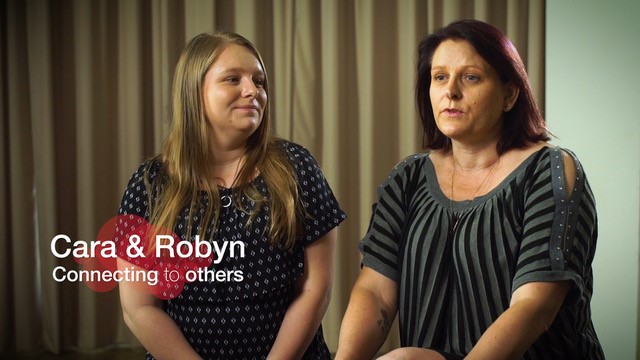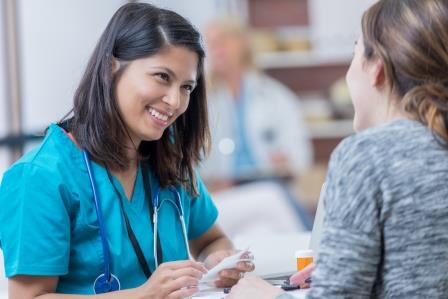ROBYN HEAL AND CARA GANNON
Robyn Heal and Cara Gannon have VWD Type 1 and are HFV Committee Members
Robyn and Cara are committed to raising awareness about von Willebrand disease (VWD) and helping women and girls with bleeding disorders to connect.

They are participating in the HFA digital stories project, which includes a video series where they talk about their experiences of living with VWD. The first video from this series was released on World Haemophilia Day in 2019. In it Robyn and Cara speak about how important it is to meet other women and young people with bleeding disorders and how valuable they have found Foundation activities such as camps and conferences as an opportunity to connect and make new friends in a relaxed environment.
Watch the video
Find out more about von Willebrand disease (VWD)
I was diagnosed with von Willebrand disease (VWD) Type 1 in my early forties. My brother was going in for surgery and his doctor wanted him to be tested for any issues that might arise. This is when we first found out about VWD. It turns out our mother was the one who has VWD and has passed it down to my brother and me. My father had haemochromatosis
and he passed that down to my other brother. I have two daughters and both have VWD
as well.
When I was younger I had lots of nose bleeds, very heavy periods and always would bleed from small paper cuts. I have suffered with low iron all my life and have to take iron tablets as well as eat high iron foods.
Raising awareness
I found out about my local foundation, Haemophilia Foundation Victoria (HFV), through the local Haemophilia Treatment Centre. I attended a national conference in Melbourne and became an HFV Committee Member as I feel there’s not enough information about VWD
and I feel that we don’t really get noticed or we get brushed off. I want to raise awareness about VWD in the wider community and help increase knowledge of VWD among health professionals.
I don’t believe many doctors or nurses are informed about VWD or how to treat people with VWD. I’ve attended hospitals for surgery and the hospital would clear the day of patients as they didn’t know if they would have an issue with me. The nurses would google my condition
in front of me, so they knew what VWD was. I would hear them talking about how to mix DDAVP (desmopressin) and they had no idea what not to do after having DDAVP.
We may be seen as a low risk group of ‘bleeders’ (although some people with VWD have severe episodes) but there is not enough awareness and support for our condition. VWD is the most common type of bleeding disorder but we rarely hear about it. Some people with VWD may have few symptoms but there are others like myself and my girls who do have issues that affect our day-to-day lives. I have suffered throughout my life with joint pain and so have my girls. I would love to know if anyone else who has VWD has any issues that they are curious about.

My name is Cara and I was diagnosed with von Willebrand disease Type 1 at around 12 years old. I was tested for VWD as a result of my uncle’s diagnosis, on my mother’s side.
My uncle was tested because of a surgery and his doctor wanted to be thorough to ensure there weren’t any complications. My mother and sister both have VWD, though they didn’t have the same symptoms as me. They were also diagnosed when I was. Looking back, I did have some of the symptoms, mainly nose bleeds, which I have had all through my childhood.
Having VWD has mainly affected the medical side of my life, and luckily hasn’t affected my personal life too much. It has been useful to know about, as I’ve had a surgery where I was able to have a treatment beforehand to control bleeding, as well as treatment in preparation for tattoos. I’ve found that not a lot of people are informed about VWD and that can be troublesome, like having to explain to some doctors what it is, and how to treat it. There are some great resources that I was given by my HTC that explained what VWD is, as well as
some resources from my Foundation that also included other people’s stories.
I learnt about HFV, my local Foundation, while attending the national conference for bleeding disorders, where I met part of the HFV committee, and other youth from Victoria, as well as others from across Australia. My mum and I decided to become Foundation members to be a part of a community with others who can help us understand our disorder, and connect
with other people with bleeding disorders. I joined the Committee to bring the perspective of a younger generation, which will always be important to help Foundations to appeal to their younger members. Through my local Foundation I would like to connect with more people with VWD. I feel like people with VWD don’t get involved as much as they should with their Foundations and it would be a great opportunity to meet people with the same disorder
as me, and share our stories with each other.
I hope that there will be more education provided to doctors about VWD, so that a doctor at a hospital doesn’t have to be taught about a condition by their patient, and I hope for more awareness and peer support groups, as I was never able to meet any other person with
a bleeding disorder until I found my local Foundation. Having VWD has opened up new opportunities for me and it will be exciting to see where those opportunities will lead.
This article was published in The Missing Factor Spring 2019, the newsletter of Haemophilia Foundation Victoria (www.hfv.org.au), and is adapted with permission.
Haemophilia Foundation Australia acknowledges the Traditional Owners and Custodians of Country throughout Australia, the land, waters and community where we walk, live, meet and work. We pay our respects to Elders past and present and extend that respect to all Aboriginal and Torres Strait Islander peoples.
Sign up for the latest news, events and our free National Haemophilia magazine